Let’s start with the bookstores. The bookstores, especially the used bookstores, were – and to a limited extent are – a part of what made/makes Telegraph Telegraph.
I am not unbiased here. I discovered the great joy of a used bookstore in the summer of 1972 – my last summer in Philadelphia – with Allen’s Bookstore at 2031 Walnut Street, Philadelphia. Mr. and Mrs. Allen remembered my grandfather, who bought from them. I was reading Tarzan and Ludwig Bemelmans and buying first edition Nero Wolfe hardcovers – not particularly heady, but the smells and feel and, well, books of used bookstores enchanted. So here are four that are gone, or sort of gone, that were part of Old Weird Telegraph.
And I probably don’t need to tell you what image of Paris strikes most deeply to my heart, do I?
Sather Gate Book Shop
On Telegraph, the grand old dame was the Sather Gate Book Shop. She lasted until October, 1972. Here are two low-quality photos of the shop, inside and out:
This 1966 photo is, to some, a photo of a pre-game football parade. To me, it is a photo of the Sather Gate Book Shop sign.
And then a great action shot of police vs. people late 1960s. It is a great photo that is made even greater because you can see the Sather Gate Book Shop sign:
It is the farthest sign on the left. You see it, don’t you? The Berkeley Inn looms behind it.
In 1967 Sather Gate Books ventured into the pages of the Barb with this advertisement for a reading. Rod McKuen came to personify the inspidid, tepid wing of the 1960s, but he ran with the Beats and his poetry was admired. I do not admit owning any of his books.
Or any of his albums.
I wonder how it would read now.
You have to make the good times yourself
take the little times and make them into big times
and save the times that are all right
for the ones that aren’t so good.
Not sure. Anyway, though – a long transcription of an oral history project entitled “The Art of Bookselling: Quail Hawkins and the Sather Gate Book Shop” may be downloaded here. Hawkins was also an author of children’s books:
You may read her obituary here.
Creed’s Book Store
Creed’s Book Store started at 2252 Telegraph (north of Bancroft) and then when the campus pushed south of Sather Gate at Bancroft at 2472 Telegraph. It was on the disorderly side of used bookstore organizing but an anchor of thought and literary exploration:
This photo features the Creed’s sign as well as Holy Hubert, the old-time-religion preacher of Telegraph Avenue.
There exists a comedic operetta about Creed’s. It was written in the late 1940s as the store’s inventory tipped from all books to half-books, half-records. The plot device was simple – it was the critical day when the number of records for sale had come to equal the number of books, so that the next acquisition or sale would determine the future of the store.
The book and lyrics were by James Cahill, Professor of the History of Art. Music was by Gordon Cyr. Cahill wrote about the opera several years ago here. It is possible to listen to the opera here.
Cody’s
I think of Cody’s – the building remains but the books are gone. Peace activist Fred Cody and his writer wife Pat opened Cody’s Books at 1838 Euclid Street just north of campus in July, 1956 with 700 titles. All paperbacks. Music break, obvious choice:
Fred and Pat Cody were at the vanguard of the paperback revolution.
Here is Fred in the doorway of the store: While still on Euclid, in 1957, the U.S. Customs Service seized as obscene three publications headed for Cody’s from a printer in England:
There were no arrests, there was no trial, nowhere the drama that was taking place across the bay with City Lights Bookstore and the Howl obscenity trial there. But still, a reminder of a different time.
A few more reminders of Cody’s time on Euclid:
In 1960, Cody’s moved to Telegraph Avenue. New dormitories on the southside had shifted the student population to south of campus, and so that’s where Cody’s headed. Attempts to rent a space on Shattuck fell through.
Cody’s stumbled into a just-closed grocery store on Telegraph and that became the new home. Here, Cody’s was at ground zero of the paperback revolution. Their ads in the Barb display a true zeal for the paperback and what it represented.
Cody’s soon outgrew the original Telegraph location and the building was headed towards condemnation – time to move again. After an unsuccessful attempt to lease the old Lucky’s Store #18 (now Amoeba Records), Cody bought the Shell gas station on the southwest corner of Telegraph and Haste and started building what we remember as Cody’s.
He opened the new store in November, 1965. Moe’s moved into the original Cody’s spot on Telegraph and was there until the building was condemned and demolished.
Telegraph had just become one-way. Businesses on the southwest corner of Dwight and Telegraph had gotten clipped when the City designed the swooping right turn. Cipped – as in, buildings demolished. The original plan was for a similar swooping left turn off Telegraph onto Haste, hence the setback of the Cody’s door.
The swooping left turn didn’t happen, but the setback did. In 1970, Fred Cody made the space available to street vendors – a Berkeley first. Until then, street vendors had congregated at the Old C.J.’s Garage south of Dwight on weekends. Now – Telegraph Avenue. And I think we all know how that grew.
Cody’s was aligned with many progressive causes in Berkeley, like the Free Clinic.
The new Cody’s. Paperbacks forever!
Forever, at least, until Cody’s closed in 2006, 50 years and 1 day after it opened. Dang!
This is one of many graphically great small ads that Cody’s placed in the Berkeley Barb in 1967. What fun!
Cody’s brought the paperback to Berkeley and throughout its history made fighting censorship a lynchpin of its business. During Free Speech Movement demonstrations and later demonstrations against the Vietnam War, Cody’s offered a safe refuge for demonstrators fleeing police batons and teargas.
Author readings were a big deal at Cody’s. And for a while Cody’s dabbled in publishing, and in at least this one case in writing:
What I remember is not the author signings or the Real Guide, but this:
When you went to the restroom, there was a blackboard inviting commentary. How Free Speech can you be?
Moe’s
Moe’s Books is still there, but I mention it here because: : (1) Old Moe’s is gone; and (2) how can you talk about Old Weird Telegraph and not talk about Moe and Moe’s? You can’t. That’s my point. Is there anything on Telegraph today that is a more important reminder of Old Weird Telegraph than Moe’s? I think not.
These images from the past give little sense of what the old weird Moe’s was.
Moe started out at 1984 Shattuck, just north of University at the present-day Turkish Kitchen.
The September 14, 1961 Berkeley Review reports a run-in between Moe and the City over his placement of kiosks with books on the sidewalk.
Sidewalk clutter vs. books! Moe moved up to Telegraph, entering into a partnership at the northeast corner of Dwight and Telegraph – where Shakespeare’s now is – named Rambam Used Paperbacks. That fell through.
In the fall of 1965, exit Rambam and enter Moe’s, with an ad in the Berkeley Barb proclaiming “Rambam is Dead. Long Live Moe’s! Everything the same (except the name).” Moe’s moved across the street to the recently-vacated Cody’s site, which was on the ground level of an apartment house widely known as the “Telegraph Hilton.”
These images of the Telegraph Hilton and Moe’s give some slight sense of the craziness that pervaded:
In this photo (above), you can see in two places the words “Red Rockets” – the name of a group of young teens who made this block of Telegraph their home. More about them when we get to Rag Theater.
Moe’s moved one store south at some point in the 1960s.
Over the years, Moe’s enjoyed a close relationship with the Print Mint, later and today known as the Reprint Mint.
In November, 1968, Moe’s took a step into history.
Owner Moe Moskowitz was arrested for selling obscene materials – R. Crumb’s Zap Comics and Snatch Comics, the S.C.U.M. Manifesto by Valeria Solanas (who shot Andy Warhol in 1968), Horseshit Magazine (The Offensive Review), and Mah Fellow Americans, editorial cartoons by the Underground Press Syndicate’s Ron Cobb.
Charges were dropped – no First Amendment / censorship / echoes of Howl and City Lights martyrdom for Moe. Back to business.
In the mid 1970s, down came the Telegraph Hilton. Adios!
Moe’s stood next to the vacant lot that had been the Hilton.
Moe built the new and current Moe’s in that vacant lot.
Moe’s had author readings and sold recods for a while.
They hosted an occasional musical event.
Moe’s and psychedlic art! Who knew? Who would guess.
In this photo, Freewheelin’ Frank of the Hells Angels joins Michael McClure in singing McClure’s song “Oh Lord, Won’t You Buy Me a Mercedes Benz.” We remember, of course, Janis Joplin’s version of the song which had so much “social and political import.”
And for a few years Moe sponsored a button contest.
Here’s another contest that Moe ran:
Of great interest – the prize – a week with Gypsy Boots. Boots, (1914-2000), born Robert Bootzin, was an actor and early advocate of health food and natural living. Raised in a vegetarian Russian-Jewish immigrant household in San Francisco, Bootzin dropped out of high school and followed his wanderlust in 1933. In the 1940’s he and a group of friends known as “Nature Boys” who called each other “tribesmen” lived in the wild in “Venice, on the Santa Monica beach, in Echo Park in Los Angeles, in the date orchards of Indio, in Tahquitz Canyon near Palm Springs,” working as fruit pickers in the Coachella Valley during the harvest season, “living in peace, enjoying a life of love and laughter.” While living in nature, Boots learned what Euell Gibbons would champion years later, that there is “more health-giving energy in some of the so-called weeds in our backyards, in the fields and woods, and in the streams, than in most of what we can get at the neighborhood grocery or restaurant.”
Moe’s gets another prize for its/his/their support of the Movement Library.
Almost everything that I know about the Movement Library is from this Barb article. For a time in the late 1960s, the headquarters of the Movement Library was above Moe’s at 2478 Telegraph, #2. You came to the library, and the library came to you.
A final Moe’s photo, taken by Richard Friedman in 1975, capturing the essence of Moe and Moe’s:
And now, we are done with the big four bookstores. Which brings us to:
There were other bookstores, now gone, about which I have found less. Most importantly, for some I have found no images and so I will improvise.
Oldest of the four honorable mention gone-but-not-forgotten’s was the Joyce Bookstore at 2475 Telegraph, owned and run as part of a small chain by Everett Cunningham. A wonderful tribute to Cunningham and his stores and his Dada campaign for Mayor of Walnut Creek (!) may be found here. My favorite line: “A typical Cunningham bookshop looked like the reference section of a public library – after somebody dropped a hand grenade in it, and homeless people moved in to sell used golf clubs.” I wish I’d said that.
According to a 1999 letter to the editor of the Chronicle from John Bell of El Cerrito: “I am writing to finally lay to rest the ‘myth of Caffe Trieste.’Every so often there will be a piece in the paper about Caffe Trieste in North Beach. It is always stated that Mr. Giotta and a partner created this Italian coffee bar in 1956 out of ‘whole cloth’ so to speak. Well, it’s just not true. The two window washers, without any cafe experience at all, bought the business from one Maxine Chiterin in 1956 when Maxine decided to move her business, Il Piccolo, to Berkeley. Maxine’s husband, Alfio, trained Mr. Giotta in the art of making espresso, cappuccino, et al, and how to roast the green coffee beans. Il Piccolo was originated by Maxine’s son, Italophile Michael Jackson in 1953, but he soon became bored and split for Italy, leaving the bar to his mother. Maxine brought in her new husband, Alfio, who was trained by Gaggia in Milan, to run it. Together with Alfio-trained barristas Joe Havens, Dick Barkley, and John Bell [the author of the letter], they operated the first real modern Italian espresso bar on the West Coast — and probably in the U.S. Alfio can be seen as the white- haired (which was the real color of his hair) fisherman in the mural on the back wall of the cafe; the mural was painted in the mid-’50s by a local San Francisco artist. Maxine then set up the Il Piccolo on Telegraph Avenue in Berkeley in half of a used bookstore. Maxine was restless just like her son, and she sold again in a couple of years and left for San Francisco and more coffee bars and the now ex-Il Piccolo in Berkeley became the Cafe Mediterranean, which it remains today.” The used bookstore was the Joyce Bookstore.
Three others were political bookstores that reflected the new direction that Berkeley took in the late 1960s.
Granma Bookstore at 2509 Telegraph, just south of Dwight, was opened by the Socialist Workers Party in 1968.
You recognize the building, no? The Soda works Building, built in 1888 to manufacture “the very best soda water.” The name of the bookstore? Of course you recognize, no?
Of course – Granma, the name of the yacht that carried Fidel Castro and his band of fighters from Mexico to launch the liberation of Cuba.
The Socialist Worker Party is a far-left organization, which today seems much more Old Left than New Left with its endless analysis, factions, and tendencies. They were, in the shorthand of the time, the Trots.
In 1972, Sue Smith of the Oakland-Berkeley Branch of the SWP wrote a thorough and detailed, if rhetorically dense, description of the store and its success.
Granma carried “as complete a line of Marxists works as possible and occupies a monopoly position with respect to Marxist classics in the East Bay.”
James Rector was on Granma’s roof when he was shot and killed by police during People’s Park uprising in 1969.
Rector (closest to the camera, in black, facing north) had stepped out onto the roof with others who were just watching.
Moving north and to another end of the left spectrum –
Yenan – now Yan’an and always 延安 – was a city near the end of the Long March by the Red Army of the Communist Party of China. It was the epicenter of the revolution from 1936 until 1948, and is remembered today as the birthplace of the Chinese revolution.
It was also the name a collectively owned and run bookstore and publisher in the alley between Haste and Dwight, just east of Telegraph.
I also have found some advertisements:
I can’t find much about the store. They published A Polemic Against the Guardian’s Revisionism, On Studying World History, and Social-Imperialism: The Soviet Union Today. That last one was a reprint form the Peking Review. Need I state that it was the Maoist counterbalance to the Trots at Grama?
Which is not to say that they had a corner on the Mao market. They didn’t. Everybody was selling the Quotations.
From advertisements in The Tribe, we see that in 1970 a feminist bookstore was open in the alley between Haste and Dwight west of Telegraph:
The mention of Susan Atkins stumps me. Could it really be Susan Atkins of the Manson Family? Author of Child of Satan, Child of God? I am really puzzled.
There are a few others that I know about, probably more that I don’t know about. I know Logos books in Santa Cruz. When I worked in Salinas for the UFW we would take Saturday night or Sunday trips to Santa Cruz to the civilization of Bookshop Santa Cruz and the Crepe Place and life other than the life of a farming town.
There was once a Logos in Berkeley, Telegraph and Channing, still here when this photo was taken in 1978. Aaron Cometbus tells us that Moe helped launch Logos. That’s all I know – so far. I am told that it was Christian-oriented. Will find out more.
Moe’s was the common ancestor of a number of other stores. More Moe’s, the rare and antiquarian shop now within Moe’s, started life around the corner at 2445 Dwight. When Moe built the new Moe’s, More Moe’s moved into the top floor.
In the space on Dwight there emerged Cartesian Books. In a high-profile area of used bookstores, Cartesian was low profile. I liked it. It closed, I think in 2010.
Shambhala Booksellers was another Moe’s offspring.
Sam Bercholz and Michael Fagan started Shambhala in 1968 in a back room at the old Moe’s. They sought to “propagate the Wisdom Traditions of the World,” selling the classics. There was an unspoken, more-or-less agreement by Moe’s, Cody’s, and Shakespeare not to carry the titles that Shambhala carried. Anti-trust, cooperation, good karma.
When Moe’s moved into the Big New Moe’s, Shambhala moved one door south on Telegraph into a space that for years had been a quiet, ignored Christian Science Reading Room. Having enjoyed the buffer from the street that they had as a back room at Moe’s, they brought in an herb shop at the Telegraph-facing east side of the space, the Lhasa Kartnak Herb Company, and operated the book store behind the herbs. Herbs as a front for books! The store closed in 2003, 35 years in the Wisdom Tradition business.
The California Book Company at Telegraph and Bancroft:
I know that I have seen photos of the store. Will find them. I promise.
While on bookstores I will mention one that is still here and still not quirky, but there is a reason to mention it – the Campus Textbook Exchange at 2470 Bancroft.
It earned a mention here because of a famous employee and a famous customer. Emily Harris, on the run and separated from her SLA colleagues who had just died in Los Angeles, walked into the Campus Textbook Exchange and struck up a conversation with a young radical working there, Kathy Soliah.
The rest is history. Soliah helped out Harris and her husband Bill and their former captive now sister-in-arms Patty Hearst. Soliah was indicted in 1976 for an SLA bank robbery and went underground. She lived under an assumed name for a long time and then got caught and did her time. But it started in a bookstore here. Clap for us! This gave the store the lovely nickname – SLA Books.
Last and least-known-about was the Lucas Book Company, of 2130 Bancroft, around the corner from Telegraph. I haven’t found out much about it. Anything about it, actually. I am pretty sure I will. And you will be the first to hear.
I went to find my friend to ask him about these photos. He was busy.
He never gets tired of is Monster Horrorscope. What can I say? He loved Old Moe’s. He had his share of adventures at the Telegraph Hilton. And most of all he loved the underground comics published by the Reprint Mint next to Moe’s. I had a hunch he was going to say “All hail to the one cosmic mind” when I asked him about the photos. He didn’t. Here is what he said:
P.S. I know I said that Lucas was the last. I present three post-last photos here of Cal Books. Cal Books is still around. It is not especially quirky, but I am a sucker for photographs of Telegraph that show a different time and way, which these do:


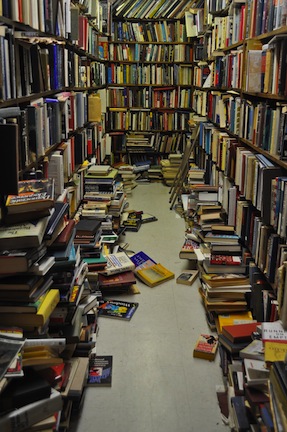




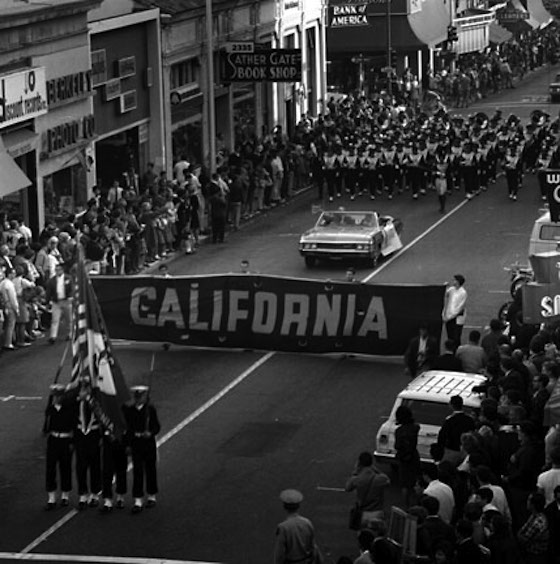







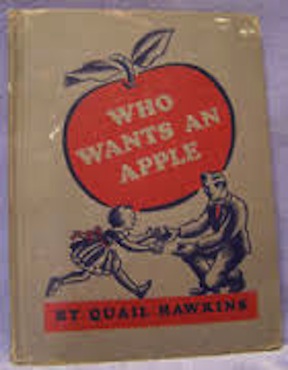




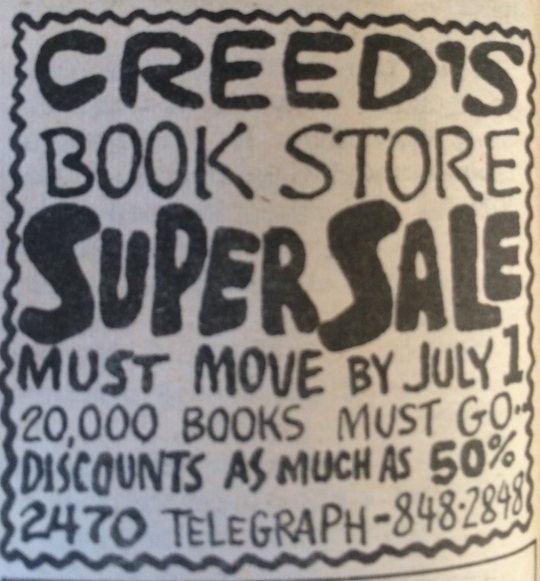





















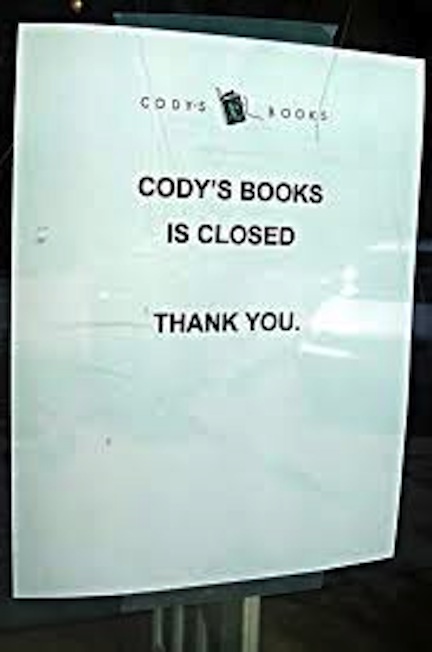


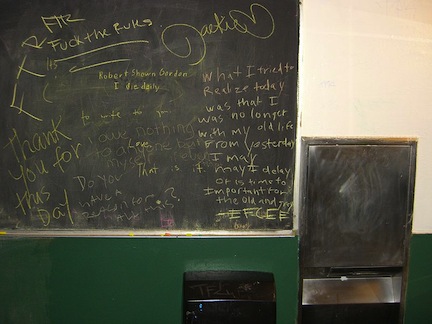




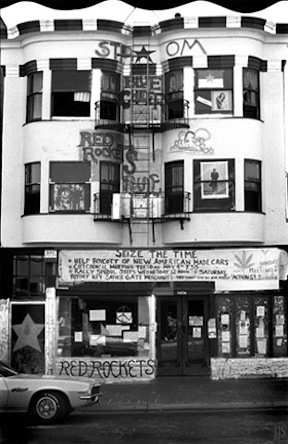


















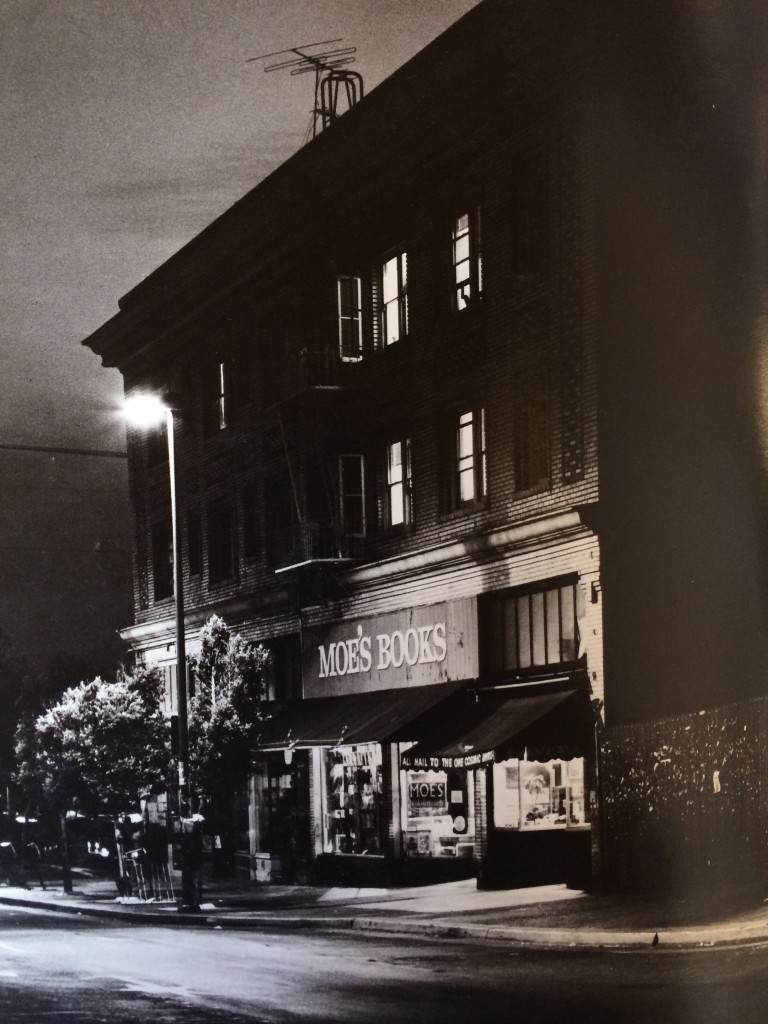





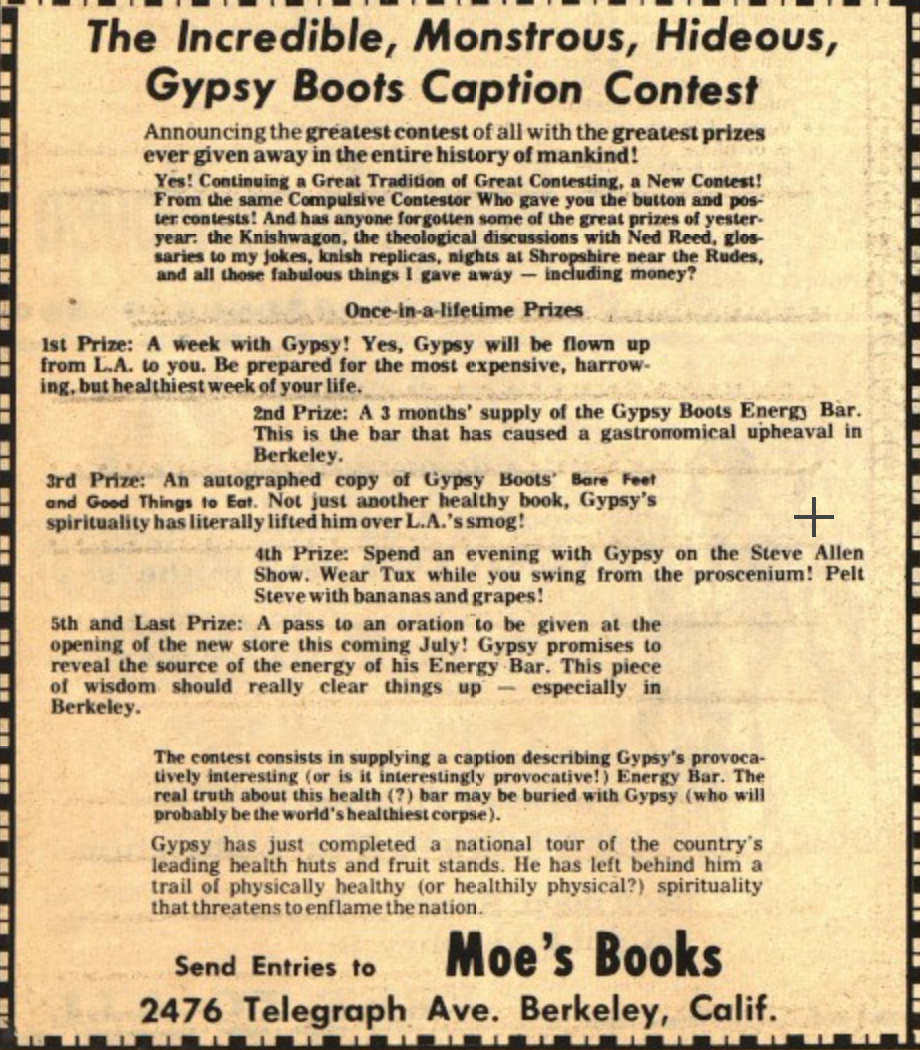





















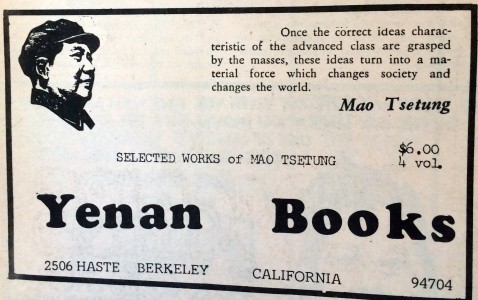







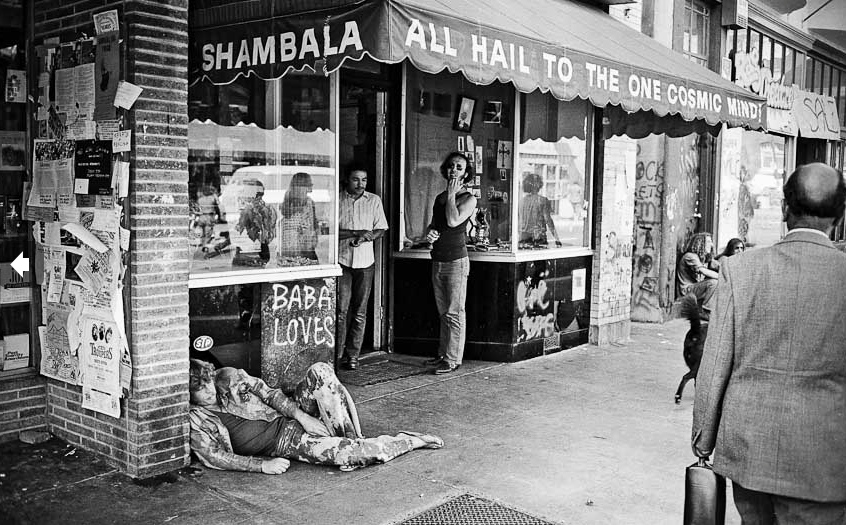




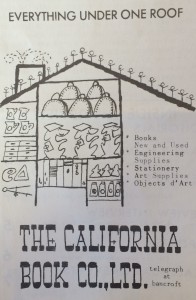



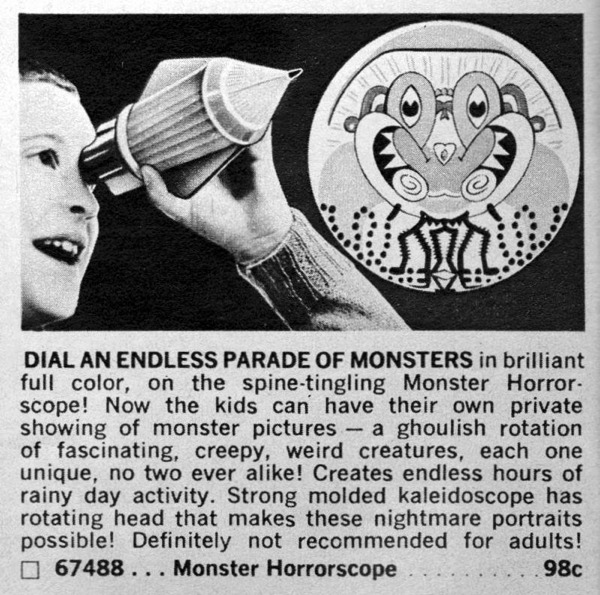




Upstart Crow on Shattuck was a good one
Pellucidar on Shattuck had books with the records
Bought some memorable books at Cartesian, a great place
Amazing website! I used to visit Cody’s and Shambala when I was out in the Bay Area (I lived in New Jersey at the time).
Sad I didn’t get to most of these amazing stores.
Great work!
Thanks,
Tom Byrne
I frequented Lucas Books from 1964 to 1970. It was a used book store. I remember finding an unusual book (I think it was about classical 78 rpm recordings). I don’t think it was known for any particular genre.
I think the owners also owned the building, which probably explained why it hung on for so long. It was not a store which would stock books for UC classes. (The stores that did this were the ASUC store, Ed Hunolt’s Berkeley Book, the Campus Textbook Exchange, and Cal Books.)
Years later University Press Books bought the building. I think they’re still there. They, and the record store Musical Offering, moved from the Durant Arcade into the old Lucas building.
Lucas Books also carried new books, at least in the biological sciences. It’s where I bought most of my books when I was in graduate school in botany in the 1970s. I have fond memories of browsing there, and Lucas would order new books I wanted that were not in stock.
Moe’s & Berkeley was featured in the movie “Who Will Stop The Rain?”1978. I am in scene #7 leaning against the wall next to the door when Michael Moriarty opens it & steps onto Tele. My son has taken a couple screen shots of my scenes for me.
Hello. I chanced upon this by way of the Berkeleyside piece on the coming closing of Annapurna.
I worked at Shambhala Booksellers from 1978 until it closed in 2003. Started as a clerk/bookseller and ended up as the owner. After that I worked at Cody’s and Moe’s until I moved to Reno for 13 years. If you are interested in fleshing out the section on Shambhala I can be texted at 775-826-4529 or e-mailed at
philipbarry1969@gmail.com
Quirky Berkeley is marvelous! Thank you.
– Philip Barry (now living in Alameda and still in the book world)